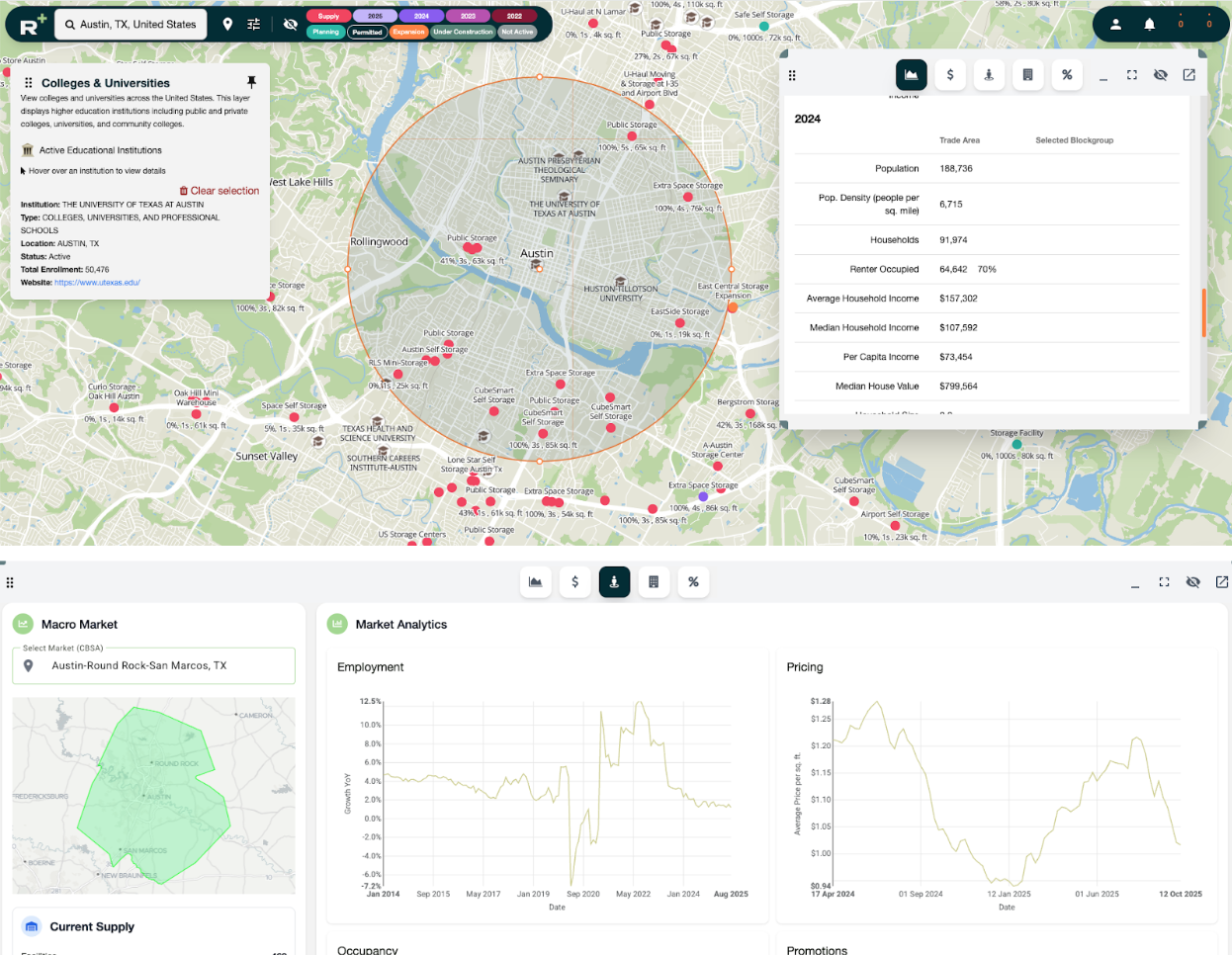
20 Oct 2025
Austin, Texas, is a textbook example of how higher education can quietly shape a local self-storage market. On the surface, it looks like any other thriving metro in the Lone Star State, with strong population growth, steady demand, and healthy occupancy. But underneath those metrics lies a less obvious driver: more than 50,000 college students moving in and out of the city each year.
With the addition of the new Colleges & Universities map layer on Radius+, operators can now see exactly how those hidden demographics influence real demand.
When a major metro also happens to host a large university, traditional market data can miss a key variable, temporary residents. These populations often don’t show up in standard demographic datasets but still generate substantial seasonal demand.
Austin is home to the University of Texas, one of the largest universities in the country, with over 50,000 enrolled students. That’s the size of a mid-sized city, tucked into an already dense trade area. According to Radius+ data, there are 188,736 people within a 3-mile radius of downtown Austin, but that number doesn’t include UT’s student population. Once factored in, the local market composition changes dramatically, especially for self-storage operators.
Take Austin’s current supply landscape. Within that same 3-mile trade area, Radius+ shows the square footage per capita (sqft per capita) sitting at 5.8. On paper, that looks like a balanced or even slightly oversupplied market.
But once you layer in the student body, those 50,000+ renters who typically need short-term storage between semesters, that ratio drops to 4.6 sqft per capita. Suddenly, Austin shifts from appearing “comfortable” to leaning undersupplied.
That’s the power of the new Colleges & Universities layer: it reveals invisible population clusters that can materially affect your understanding of local demand. Without it, operators might underestimate how seasonal pressures shape their markets, particularly during move-out and move-in periods.
Texas markets already experience strong cyclical demand due to weather and relocation trends. But in Austin, the self-storage calendar syncs closely with the academic year.
Late Spring: As the school year ends, student move-outs surge. Units near campus fill quickly as students pack up and leave town.
Late Summer: Demand spikes again as students return and need short-term storage before leases start.
Winter: The market stabilizes, with many facilities offering student-focused promotions to maintain occupancy.
These consistent peaks aren’t random; they’re predictable, and they present a clear opportunity for revenue optimization.
For owner-operators, understanding when these surges occur allows for smarter rent adjustments and staffing decisions. The Market Analytics data for the Austin-Round Rock-San Marcos CBSA shows exactly how these fluctuations play out year over year.
Rates in Austin historically trend upward in late spring and early summer, aligning with the student cycle. Using the Colleges & Universities layer in combination with the Pricing and Occupancy dashboards, operators can:
Identify which facilities sit closest to high-enrollment campuses.
Monitor rate changes and occupancy trends across semesters.
Adjust promotions or rental rates ahead of predictable demand spikes.
Even small timing adjustments, like increasing rates two weeks before peak move-out season, can yield noticeable gains.
College populations represent a unique kind of hidden demand. They don’t appear in Census data, yet they impact leasing velocity, seasonal vacancy, and pricing strategy. For developers, this means a location that looks adequately supplied on paper may, in reality, have room for new product. For existing operators, it means understanding your true occupancy drivers and timing rent adjustments around predictable peaks.
The Colleges & Universities layer bridges that gap. By visualizing educational institutions directly on the map, you can now connect demographic realities to operational strategy. In Austin, that insight turns what looks like a saturated market into one defined by cyclical opportunity.
Whether you operate near Austin, Ann Arbor, or Tallahassee, university towns across the country share one thing in common: demand that moves with the academic calendar. Radius+ now makes it easier than ever to see that movement before it happens.
Discover the new Colleges & Universities map layer today and uncover the hidden demographics shaping your market.

Alexander Reams is a Product Specialist at Radius+, where he helps operators, investors, and developers uncover smarter ways to use self-storage data. His role focuses on translating technical tools into everyday workflows that save time and drive results.